HYUNDAI NEXO 2023 Owners Manual
Manufacturer: HYUNDAI, Model Year: 2023, Model line: NEXO, Model: HYUNDAI NEXO 2023Pages: 558, PDF Size: 35.01 MB
Page 501 of 558
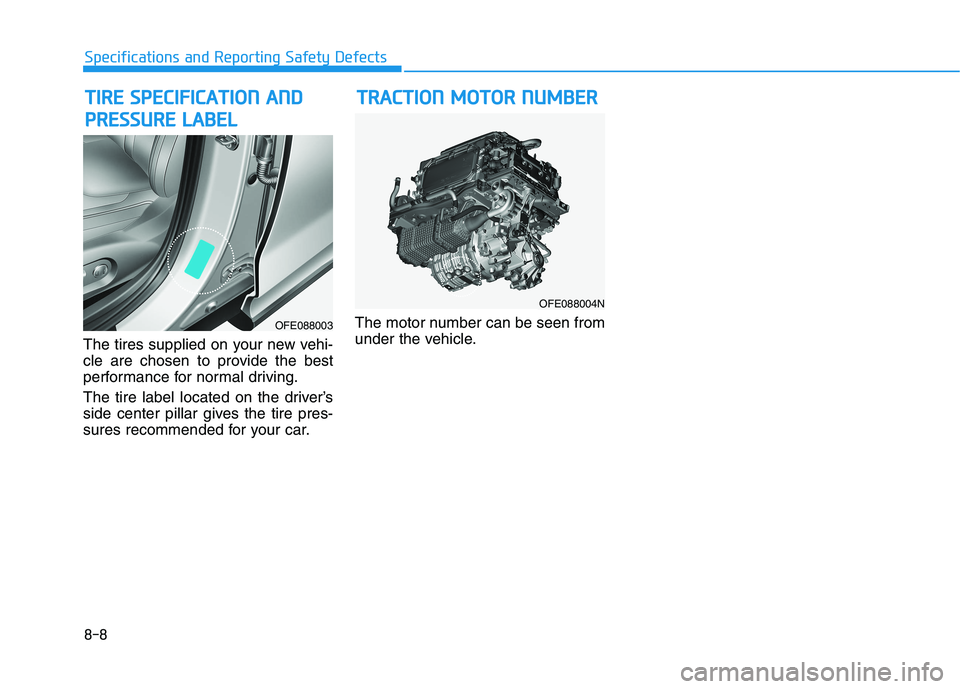
8-8
Specifications and Reporting Safety Defects
The tires supplied on your new vehi-
cle are chosen to provide the best
performance for normal driving.
The tire label located on the driver’s
side center pillar gives the tire pres-
sures recommended for your car.The motor number can be seen from
under the vehicle.
TT
RR AA CCTT IIOO NN MM OOTTOO RR NN UU MM BBEERR
TT IIRR EE SS PP EECCIIFF IICC AA TTIIOO NN AA NN DD
P
P RR EESSSSUU RREE LL AA BBEELL
OFE088003
OFE088004N
Page 502 of 558
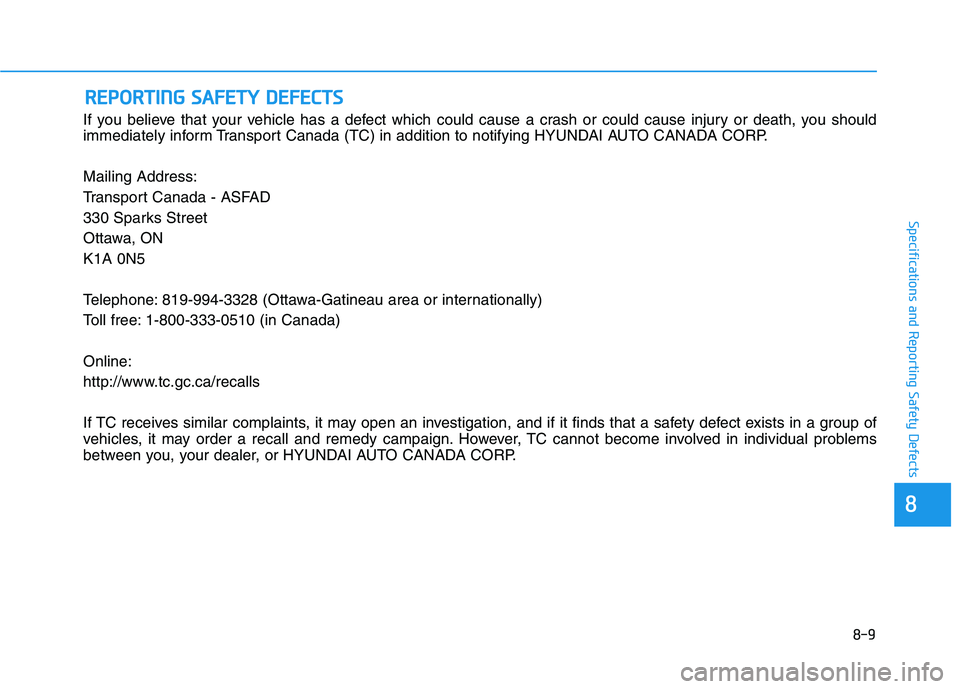
8-9
88
Specifications and Reporting Safety Defects
If you believe that your vehicle has a defect which could cause a crash or could cause injury or death, you should
immediately inform Transport Canada (TC) in addition to notifying HYUNDAI AUTO CANADA CORP. Mailing Address:
Transport Canada - ASFAD
330 Sparks Street
Ottawa, ON K1A 0N5
Telephone: 819-994-3328 (Ottawa-Gatineau area or internationally)
Toll free: 1-800-333-0510 (in Canada) Online:
http://www.tc.gc.ca/recalls
If TC receives similar complaints, it may open an investigation, and if it finds that a safety defect exists in a group of
vehicles, it may order a recall and remedy campaign. However, TC cannot become involved in individual problems
between you, your dealer, or HYUNDAI AUTO CANADA CORP.
RREEPP OO RRTTIINN GG SS AA FFEE TT YY DD EEFFEE CCTT SS
Page 503 of 558
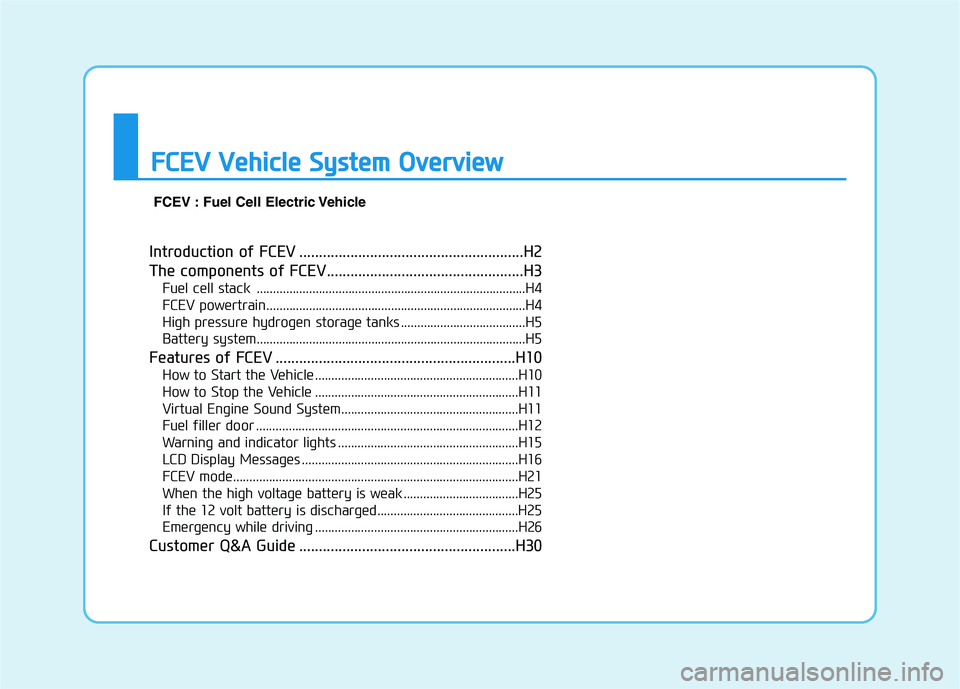
Introduction of FCEV .........................................................H2
The components of FCEV..................................................H3Fuel cell stack ..................................................................................H4
FCEV powertrain...............................................................................H4
High pressure hydrogen storage tanks ......................................H5
Battery system..................................................................................H5
Features of FCEV .............................................................H10 How to Start the Vehicle ..............................................................H10
How to Stop the Vehicle ..............................................................H11
Virtual Engine Sound System......................................................H11
Fuel filler door ................................................................................H12
Warning and indicator lights .......................................................H15
LCD Display Messages ..................................................................H16
FCEV mode.......................................................................................H21
When the high voltage battery is weak ...................................H25
If the 12 volt battery is discharged...........................................H25
Emergency while driving ..............................................................H26
Customer Q&A Guide .......................................................H30
FF CC EE VV VV eehh iicc llee SS yyssttee mm OO vvee rrvv iiee ww
FCEV : Fuel Cell Electric Vehicle
Page 504 of 558
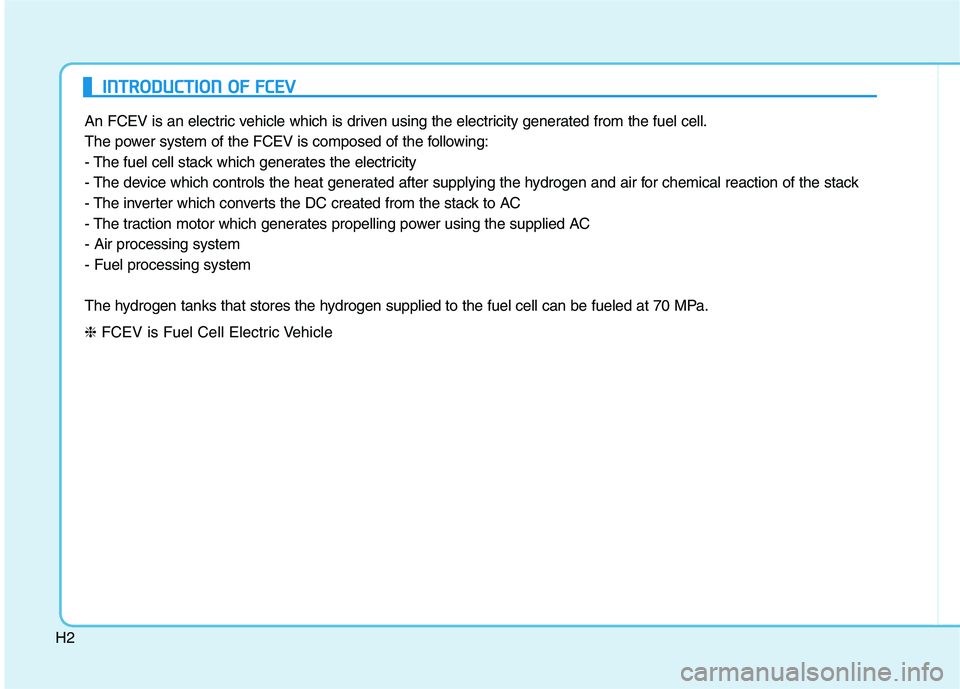
H2
An FCEV is an electric vehicle which is driven using the electricity generated from the fuel cell.
The power system of the FCEV is composed of the following:
- The fuel cell stack which generates the electricity
- The device which controls the heat generated after supplying the hydrogen and air for chemical reaction of the stack
- The inverter which converts the DC created from the stack to AC
- The traction motor which generates propelling power using the supplied AC- Air processing system- Fuel processing system
The hydrogen tanks that stores the hydrogen supplied to the fuel cell can be fueled at 70 MPa. ❈FCEV is Fuel Cell Electric Vehicle
IINN TTRR OO DDUU CCTT IIOO NN OO FF FF CC EE VV
Page 505 of 558
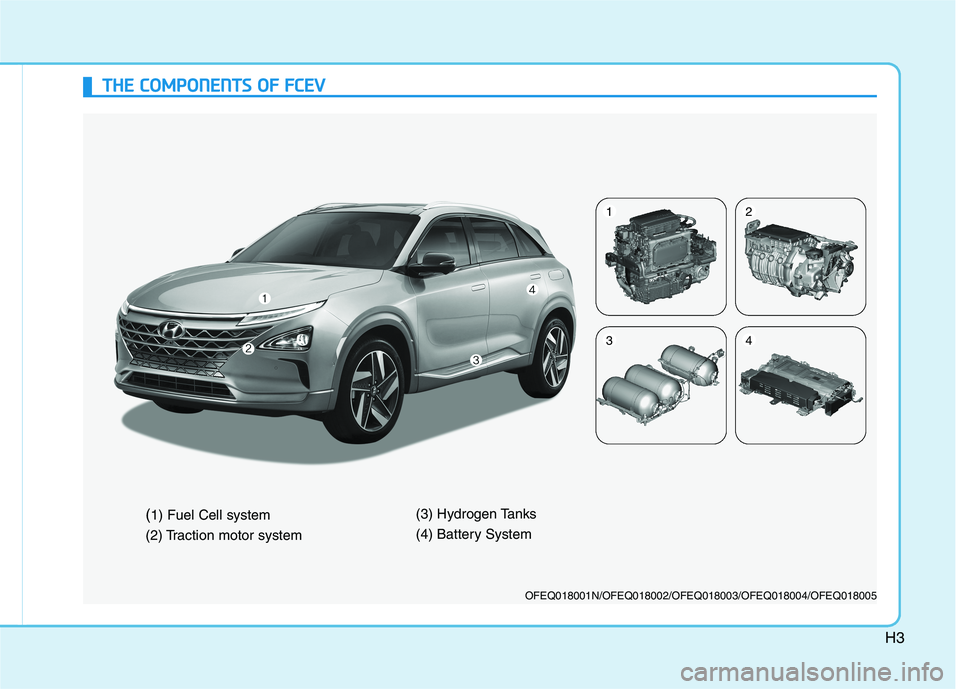
H3
TTHH EE CC OO MM PPOO NNEENN TTSS OO FF FF CC EE VV
OFEQ018001N/OFEQ018002/OFEQ018003/OFEQ018004/OFEQ018005
(1) Fuel Cell system
(2) Traction motor system (3) Hydrogen Tanks
(4) Battery System
12
34
Page 506 of 558
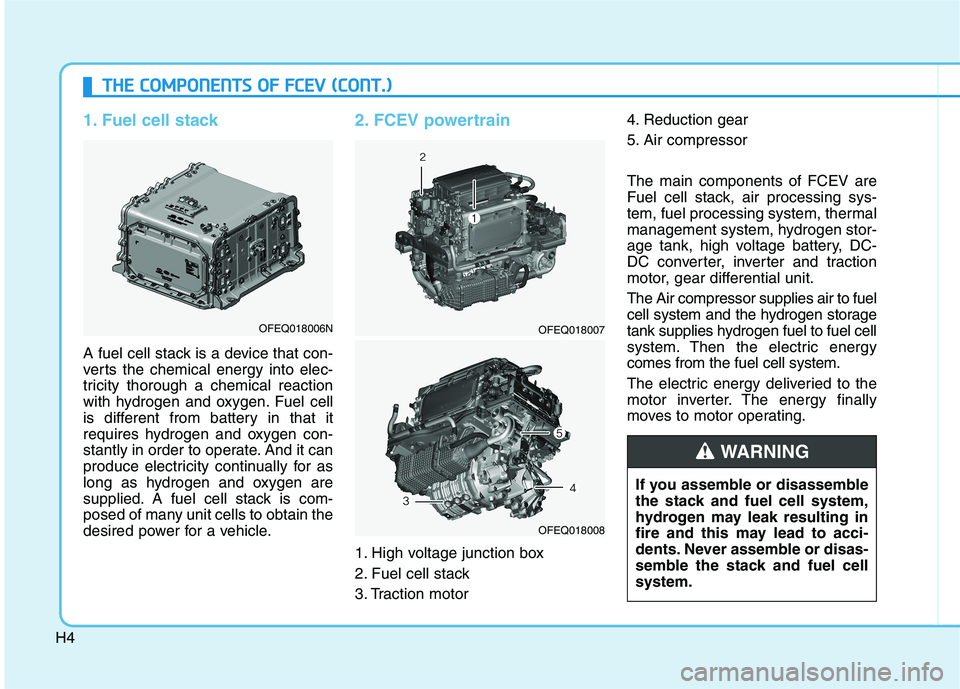
H4
1. Fuel cell stack
A fuel cell stack is a device that con-
verts the chemical energy into elec-
tricity thorough a chemical reaction
with hydrogen and oxygen. Fuel cell
is different from battery in that it
requires hydrogen and oxygen con-
stantly in order to operate. And it can
produce electricity continually for as
long as hydrogen and oxygen are
supplied. A fuel cell stack is com-
posed of many unit cells to obtain the
desired power for a vehicle.
2. FCEV powertrain
1. High voltage junction box
2. Fuel cell stack
3. Traction motor4. Reduction gear
5. Air compressor The main components of FCEV are
Fuel cell stack, air processing sys-
tem, fuel processing system, thermal
management system, hydrogen stor-
age tank, high voltage battery, DC-
DC converter, inverter and traction
motor, gear differential unit. The Air compressor supplies air to fuel
cell system and the hydrogen storage
tank supplies hydrogen fuel to fuel cell
system. Then the electric energycomes from the fuel cell system.
The electric energy deliveried to the
motor inverter. The energy finally
moves to motor operating.
TT
HH EE CC OO MM PPOO NNEENN TTSS OO FF FF CC EE VV (( CC OO NNTT..))
OFEQ018006NOFEQ018007
OFEQ018008
If you assemble or disassemble
the stack and fuel cell system,
hydrogen may leak resulting in
fire and this may lead to acci-
dents. Never assemble or disas-
semble the stack and fuel cellsystem.
WARNING
Page 507 of 558
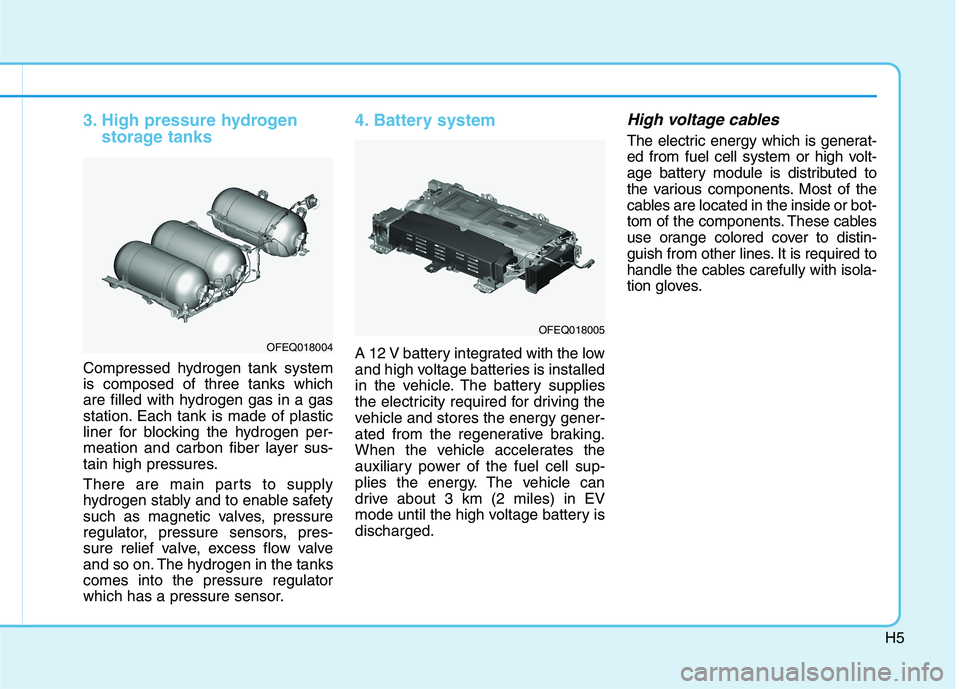
H5
3. High pressure hydrogenstorage tanks
Compressed hydrogen tank system is composed of three tanks which
are filled with hydrogen gas in a gas
station. Each tank is made of plastic
liner for blocking the hydrogen per-
meation and carbon fiber layer sus-
tain high pressures.
There are main parts to supply
hydrogen stably and to enable safety
such as magnetic valves, pressure
regulator, pressure sensors, pres-
sure relief valve, excess flow valve
and so on. The hydrogen in the tankscomes into the pressure regulator
which has a pressure sensor.
4. Battery system
A 12 V battery integrated with the low
and high voltage batteries is installed
in the vehicle. The battery supplies
the electricity required for driving the
vehicle and stores the energy gener-
ated from the regenerative braking.
When the vehicle accelerates the
auxiliary power of the fuel cell sup-
plies the energy. The vehicle can
drive about 3 km (2 miles) in EV
mode until the high voltage battery isdischarged.
High voltage cables
The electric energy which is generat-
ed from fuel cell system or high volt-
age battery module is distributed to
the various components. Most of the
cables are located in the inside or bot-
tom of the components. These cables
use orange colored cover to distin-
guish from other lines. It is required to
handle the cables carefully with isola-
tion gloves.
OFEQ018004
OFEQ018005
Page 508 of 558
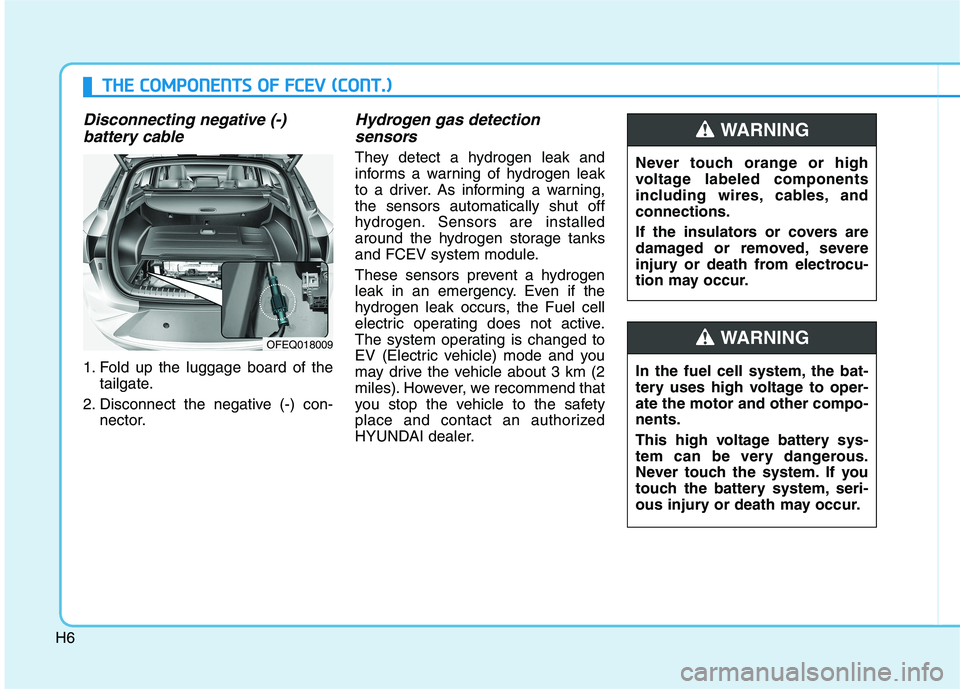
H6
Disconnecting negative (-) battery cable
1. Fold up the luggage board of the tailgate.
2. Disconnect the negative (-) con- nector.
Hydrogen gas detection
sensors
They detect a hydrogen leak and
informs a warning of hydrogen leak
to a driver. As informing a warning,the sensors automatically shut off
hydrogen. Sensors are installed
around the hydrogen storage tanks
and FCEV system module.
These sensors prevent a hydrogen
leak in an emergency. Even if the
hydrogen leak occurs, the Fuel cell
electric operating does not active.
The system operating is changed to
EV (Electric vehicle) mode and you
may drive the vehicle about 3 km (2
miles). However, we recommend that
you stop the vehicle to the safety
place and contact an authorized
HYUNDAI dealer.
OFEQ018009
TT HH EE CC OO MM PPOO NNEENN TTSS OO FF FF CC EE VV (( CC OO NNTT..))
Never touch orange or high
voltage labeled components
including wires, cables, andconnections.
If the insulators or covers are
damaged or removed, severe
injury or death from electrocu-
tion may occur.
WARNING
In the fuel cell system, the bat-
tery uses high voltage to oper-ate the motor and other compo-nents.
This high voltage battery sys-
tem can be very dangerous.
Never touch the system. If you
touch the battery system, seri-
ous injury or death may occur.
WARNING
Page 509 of 558
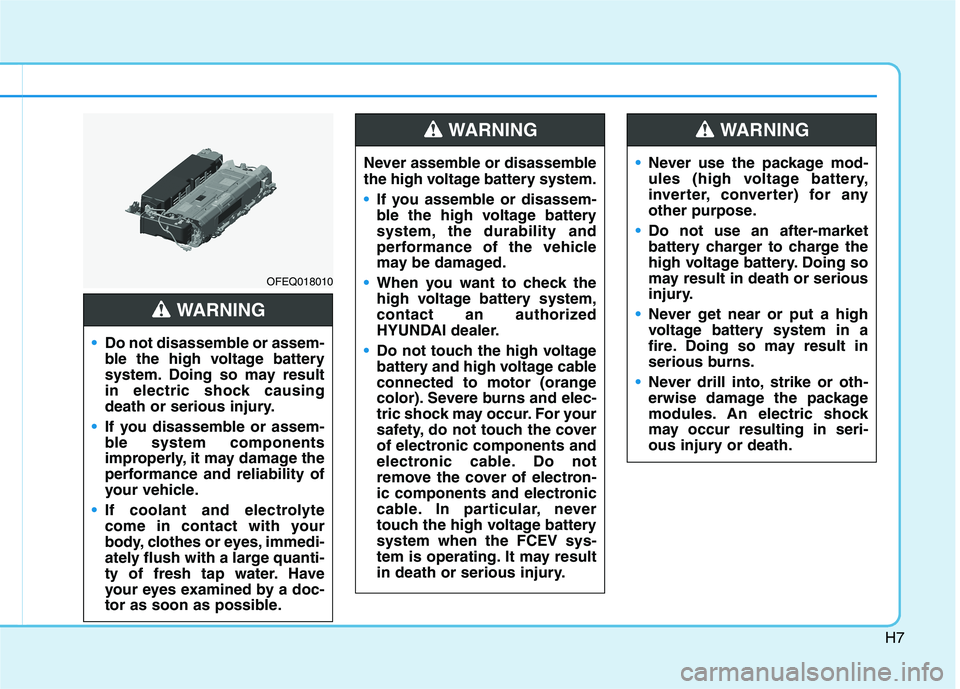
H7
OFEQ018010
•Do not disassemble or assem-
ble the high voltage battery
system. Doing so may result
in electric shock causing
death or serious injury.
If you disassemble or assem-
ble system components
improperly, it may damage the
performance and reliability of
your vehicle.
If coolant and electrolyte
come in contact with your
body, clothes or eyes, immedi-
ately flush with a large quanti-
ty of fresh tap water. Have
your eyes examined by a doc-
tor as soon as possible.
WARNING
Never assemble or disassemble
the high voltage battery system.
If you assemble or disassem-
ble the high voltage battery
system, the durability and
performance of the vehicle
may be damaged.
When you want to check the
high voltage battery system,
contact an authorized
HYUNDAI dealer.
Do not touch the high voltage
battery and high voltage cable
connected to motor (orange
color). Severe burns and elec-
tric shock may occur. For your
safety, do not touch the cover
of electronic components and
electronic cable. Do not
remove the cover of electron-
ic components and electronic
cable. In particular, never
touch the high voltage batterysystem when the FCEV sys-
tem is operating. It may result
in death or serious injury.
WARNING
Never use the package mod-
ules (high voltage battery,
inverter, converter) for any
other purpose.
Do not use an after-market
battery charger to charge the
high voltage battery. Doing so
may result in death or serious
injury.
Never get near or put a high
voltage battery system in a
fire. Doing so may result in
serious burns.
Never drill into, strike or oth-
erwise damage the package
modules. An electric shock
may occur resulting in seri-
ous injury or death.
WARNING
Page 510 of 558
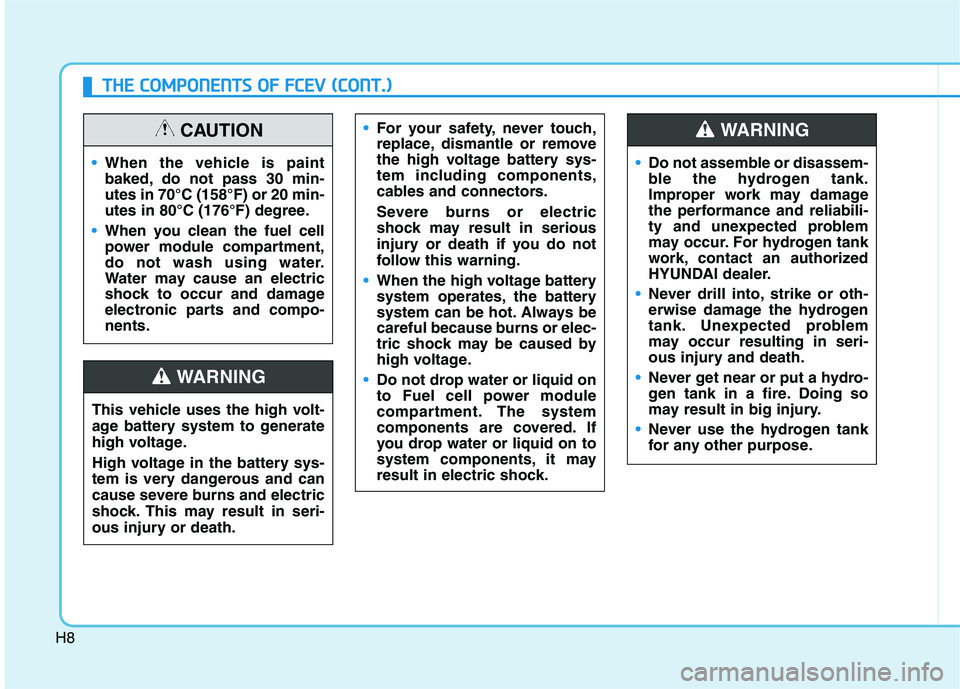
H8
TTHH EE CC OO MM PPOO NNEENN TTSS OO FF FF CC EE VV (( CC OO NNTT..))
This vehicle uses the high volt-
age battery system to generate
high voltage.
High voltage in the battery sys-
tem is very dangerous and can
cause severe burns and electric
shock. This may result in seri-
ous injury or death.
For your safety, never touch,
replace, dismantle or remove
the high voltage battery sys-
tem including components,
cables and connectors.
Severe burns or electric
shock may result in serious
injury or death if you do not
follow this warning.
When the high voltage battery
system operates, the battery
system can be hot. Always be
careful because burns or elec-
tric shock may be caused by
high voltage.
Do not drop water or liquid on
to Fuel cell power module
compartment. The system
components are covered. If
you drop water or liquid on to
system components, it may
result in electric shock.WARNING
When the vehicle is paint
baked, do not pass 30 min-utes in 70°C (158°F) or 20 min-
utes in 80°C (176°F) degree.
When you clean the fuel cell
power module compartment,
do not wash using water.
Water may cause an electric
shock to occur and damage
electronic parts and compo-nents.
CAUTION
Do not assemble or disassem-
ble the hydrogen tank.
Improper work may damage
the performance and reliabili-
ty and unexpected problem
may occur. For hydrogen tank
work, contact an authorized
HYUNDAI dealer.
Never drill into, strike or oth-
erwise damage the hydrogen
tank. Unexpected problem
may occur resulting in seri-
ous injury and death.
Never get near or put a hydro-
gen tank in a fire. Doing so
may result in big injury.
Never use the hydrogen tank
for any other purpose.
WARNING